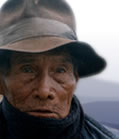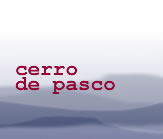 |
 |
||
 |
|||
|
RELATED THEMES festivals gender history spiritual beliefs OTHER LOCAL THEMES BACKGROUND |
culture and customs
Anyone reading these interviews is left with a sense of a still vibrant culture. While many narrators emphasise the declining importance of tradition to recent generations, young and old alike describe with enthusiasm games, dances, songs, special foods, festivals, and other celebrations. Some are not as lavish as they used to be; others have been affected by the changes in the social and physical landscape. Modification is not new: several point out how the influx of outsiders who came to work in the mines brought new customs and music which were gradually absorbed into the local culture. One felt this was enriching; another that local custom lost out to "foreign" influence. Some customs date back to the Spanish colonial era; others are more purely Andean. Many festivities are connected to religion; others celebrate age-old aspects of rural life. And some combine the different elements. Despite the pollution of the land, the loss of livestock, and the decline of herding as a way of life, for example, people still celebrate their connection with the mountain: "Grandfather" or "the Great Shepherd". "The animals' feast is celebrated with Carnival in February and March. We begin with the first ritual which is taking a table up the mountain with an offering of coca, liquor, fruit and sweets. We take this offering to the mountain, the patron of the animals, because the mountain looks after the animals and all livestock-owners have absolute faith in him..." (Peru 30). Here, as in many customs, Catholic elements are combined with agrarian traditions. One narrator (Peru 25) works as an archivist. Now the area is dominated by the mining industry, he feels, there is an urgent need to record its cultural history, since once its resources are depleted, "we're destined to disappear. Look at the experiences of other mining towns such as Potosi in Bolivia. we have put all our energies into writing about our cultural roots, we have to record our roots.mining can only last 60 or 70 years more. Cerro de Pasco will disappear which is why we have to leave proof that our town, our people, existed". Although a number of narrators use Quecha words, many say the language is dying out. One 70-year-old woman teases the interviewer by speaking in Quecha: "I'm not going to translate so that you can learn Quechua too. Find out for yourself. I might have insulted you" (Peru 11). One custom relates to mining but says more about attitudes towards women: "They say that if a woman goes into the mine there'll be a tragedy of some kind, that's what they believe ... it's forbidden, they say it'll cause a disaster, deaths, cave-ins and all that. So don't even think about that, it's not possible. My dad says it comes from the pachamama tradition (mother earth). She doesn't allow women to enter her" (Peru 27). quotes about culture and customs"Life and happiness especially in Cerro de Pasco, a mining town, means permanently dealing with problems. That's why the huaynos, mulisas, chimaychas and the pasacalles of Cerro de Pasco are not for dancing or for getting drunk to, they're songs to listen to... Someone once said to me - but these songs are so sad they make you cry. It's because they have pillaged this place, not only minerals but also our thoughts.The songs are a testament, they're like banners, or loud-speakers through which we make known our laments and pains, but also our hopes and good-fortunes." "We cannot continue losing our true culture.This area of campesina communities was strictly cattle-based and logically became a mining area. I am from a campesino community, my family and I are witnesses to the changes and we really want to preserve some of our customs which are part of our tradition and our heritage...We need to value our traditions much more and persist with our customs because this is what identifies us..." "When we choose the coca, we choose the best leaves and we put them in the glass for the mountain or the Auquillo, and that's the way we share with our patron, with the Grandfather, with the Great Shepherd. We give this to him in faith and with love so that in the next year the little leaves in the glass will become good crops.If you have offered up a good table, and you have given it in faith, your animals will double in number next year, that's what we believe. Both small and large farmers alike do this. Each year they bring the legacy back to life. Though there have been some changes over time, the essence of this is the same, the relationship between campesinos and the land." "Well, the customs of my community. they mainly come from the Spanish, their fiestas and all that, and clearly we've lost the customs more than ever with the mining company of Centromin. Before mining, there was more solidarity in my community, we were more united, there was an understanding. We celebrated fiestas. since the foreigners came along, we've lost our customs, our culture and quite frankly even our own huaynitos (dance). No one sings our songs anymore, people can't dance. What's worse though is that the foreign culture is taking over, they dance rock here, they dance chicha, the result being that we're losing our sense of community completely, and my community and this whole area, more than anything the Huanca culture is being penetrated [from outside]. People don't even dance to their traditional songs any more." "Thousands of workers [came from other areas]. it was quite normal to find people from Jauja, Huancavelica, Quebrada de Chaupihuaranga, Puno but few Cerreños.The result of several decades of this is the great mixing which is so characteristic of Cerro de Pasco. Little by little the migrant workers found consolation from the solitude and the harshness of the work in the women of the Cerro. by this time they are their children or grandchildren but they still feel and treasure the culture brought by their fathers or grandfathers.we can see evidence of the different cultures and music which come from other Andean regions, and they are now part of Cerro de Pasco's culture." "Quechua is spoken nowhere because in practice it isn't permitted. It's not that it's prohibited, but it's the same. Do they teach you how to speak Quechua at school like they teach you how to speak Spanish? What is the official language? It's Spanish, isn't it? If you go to a public office, does anyone speak Quechua? This is why people stop speaking their language and it's lost, there's no way to practice it. Well [I have] some phrases, some words. my parents [are] the only ones I have been able to speak with. That's why it's almost lost. It's because of this I feel my parents have been a great school for me." "[Migrants] from Quiulacocha come back for the fiestas and celebrate with their brothers in the community. They never forget the saint's days, they don't forget the dances and they enjoy them together. This is why the fiestas are beautiful. Us young people recognise this and we join in, but this doesn't stop us from dancing to other music and dances. But we keep our customs here I think, more than in the cities." "It was only when I finished my studies that I began to do something about them with young people from Rancas. The first thing we did was to set up the Manuel Scorza Cultural Grouping and we set about collecting stories from our land and researching local issues... We also organised musical groups and we saw that this experience had to be made public somehow or other. This we did through a piece of theatre which we eventually took to the National Theatre Meeting in Lima... Our theatre was essentially based on rural life showing the strong bond campesinos have with nature, and well, ... we were well praised, it was a way of bringing together experiences of rural and urban life." |
|